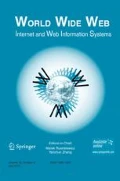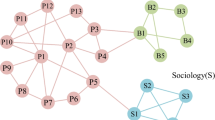Abstract
Bipartite graphs, which consist of two different types of entities, are widely used to model many real-world applications. In bipartite networks, (α,β)-core is an essential model to measure the entity engagement. In this paper, we propose and investigate the problem of (α,β)-core minimization, which aims to identify a set of b edges whose deletion can minimize the size of resulting collapsed (α,β)-core. To our best knowledge, this is the first work to investigate the (α,β)-core minimization problem in bipartite graph. We prove the problem is NP-hard and our object function is monotonic but not submodular. Then, we propose a baseline algorithm by invoking the greedy framework. To reduce the computation cost and candidate space, novel pruning techniques are devised. We further develop a group based algorithm to optimize the search. Finally, we conduct comprehensive experiments over 6 real-life bipartite networks to demonstrate the advantages of the proposed techniques.








Similar content being viewed by others
References
Ahmed, A., Batagelj, V., Fu, X., Hong, S., Merrick, D., Mrvar, A.: Visualisation and analysis of the internet movie database. In: APVIS (2007)
Albert, R., Jeong, H., Barabási, A.L.: Error and attack tolerance of complex networks. Nature (2000)
Beutel, A., Xu, W., Guruswami, V., Palow, C., Faloutsos, C.: Copycatch: stopping group attacks by spotting lockstep behavior in social networks. In: WWW (2013)
Bola, M., Sabel, B.A.: Dynamic reorganization of brain functional networks during cognition. Neuroimage (2015)
Bonchi, F., Khan, A., Severini, L.: Distance-generalized core decomposition. In: SIGMOD (2019)
Borgatti, S.P., Everett, M.G.: Network analysis of 2-mode data Social networks (1997)
Carmi, S., Havlin, S., Kirkpatrick, S., Shavitt, Y., Shir, E.: A model of internet topology using k-shell decomposition. In: Proceedings of the national academy of sciences (2007)
Cerinšek, M., Batagelj, V.: Generalized two-mode cores. Social Networks (2015)
Chang, L., Yu, J.X., Qin, L., Lin, X., Liu, C., Liang, W.: Efficiently computing k-edge connected components via graph decomposition. In: SIGMOD (2013)
Chen, C., Tong, H., Prakash, B.A., Eliassi-Rad, T., Faloutsos, M., Faloutsos, C.: Eigen-optimization on large graphs by edge manipulation. TKDD (2016)
Cheng, J., Ke, Y., Fu, A.W., Yu, J.X., Zhu, L.: Finding maximal cliques in massive networks by h*-graph. In: SIGMOD (2010)
Ding, D., Li, H., Huang, Z., Mamoulis, N.: Efficient fault-tolerant group recommendation using alpha-beta-core. In: CIKM (2017)
Hochbaum, D. S.: Approximating clique and biclique problems. J. Alg. (1998)
Hooi, B., Song, H.A., Beutel, A., Shah, N., Shin, K., Faloutsos, C.: FRAUDAR: bounding graph fraud in the face of camouflage. In: SIGKDD (2016)
Huang, X., Cheng, H., Qin, L., Tian, W., Yu, J. X.: Querying k-truss community in large and dynamic graphs. In: SIGMOD (2014)
Laishram, R., Sariyüce, A.E., Eliassi-Rad, T., Pinar, A., Soundarajan, S.: Residual core maximization: An efficient algorithm for maximizing the size of the k-core. In: SDM (2020)
Lehmann, S., Schwartz, M., Hansen, L.K.: Biclique communities. Phys. Rev. E (2008)
Liu, B., Yuan, L., Lin, X., Qin, L., Zhang, W., Zhou, J.: Efficient (α, β)-core computation: An index-based approach. In: WWW (2019)
Liu, G., Sim, K., Li, J.: Efficient mining of large maximal bicliques. In: DaWaK (2006)
Robins, G., Alexander, M.: Small worlds among interlocking directors: Network structure and distance in bipartite graphs. Comput. Math. Organ. Theory (2004)
Seidman, S.B.: Network structure and minimum degree. Social Netw. (1983)
Sun, R., Chen, C., Wang, X., Zhang, Y., Wang, X.: Stable community detection in signed social networks. TKDE (2020)
Sun, R., Zhu, Q., Chen, C., Wang, X., Zhang, Y., Wang, X.: Discovering cliques in signed networks based on balance theory. In: DASFAA, pp. 666–674 (2020)
Wang, J., De Vries, A.P., Reinders, M.J.: Unifying user-based and item-based collaborative filtering approaches by similarity fusion. In: SIGIR (2006)
Wang, K., Lin, X., Qin, L., Zhang, W., Zhang, Y.: Vertex priority based butterfly counting for large-scale bipartite networks. VLDB (2019)
Wang, K., Lin, X., Qin, L., Zhang, W., Zhang, Y.: Efficient bitruss decomposition for large-scale bipartite graphs. In: ICDE (2020)
Wang, X., Zhang, Y., Zhang, W., Lin, X.: Efficient distance-aware influence maximization in geo-social networks. TKDE 29(3), 599–612 (2016)
Wang, X., Zhang, Y., Zhang, W., Lin, X., Chen, C.: Bring order into the samples: A novel scalable method for influence maximization. TKDE 29(2), 243–256 (2016)
Wu, Y., Zhao, J., Sun, R., Chen, C., Wang, X.: Efficient personalized influential community search in large networks. In: APWeb-WAIM (2020)
Zhang, F., Li, C., Zhang, Y., Qin, L., Zhang, W.: Finding critical users in social communities: The collapsed core and truss problems. TKDE (2020)
Zhao, J., Sun, R., Zhu, Q., Wang, X., Chen, C.: Community identification in signed networks: A k-truss based model. In: CIKM, pp. 2321–2324 (2020)
Zhou, R., Liu, C., Yu, J.X., Liang, W., Chen, B., Li, J.: Finding maximal k-edge-connected subgraphs from a large graph. In: EDBT (2012)
Zhu, W., Chen, C., Wang, X., Lin, X.: K-core minimization: An edge manipulation approach. In: CIKM (2018)
Zhu, W., Zhang, M., Chen, C., Wang, X., Zhang, F., Lin, X.: Pivotal relationship identification: The k-truss minimization problem. In: IJCAI (2019)
Acknowledgements
This work is support by NSFC 61802345, ZJNSF LQ20F020007, ZJNSF LY21F020012 and Y202045024.
Author information
Authors and Affiliations
Corresponding author
Additional information
Publisher’s note
Springer Nature remains neutral with regard to jurisdictional claims in published maps and institutional affiliations.
This article belongs to the Topical Collection: Special Issue on Large Scale Graph Data Analytics Guest Editors: Xuemin Lin, Lu Qin, Wenjie Zhang, and Ying Zhang
Rights and permissions
About this article
Cite this article
Chen, C., Zhu, Q., Wu, Y. et al. Efficient critical relationships identification in bipartite networks. World Wide Web 25, 741–761 (2022). https://doi.org/10.1007/s11280-021-00914-2
Received:
Revised:
Accepted:
Published:
Issue Date:
DOI: https://doi.org/10.1007/s11280-021-00914-2




